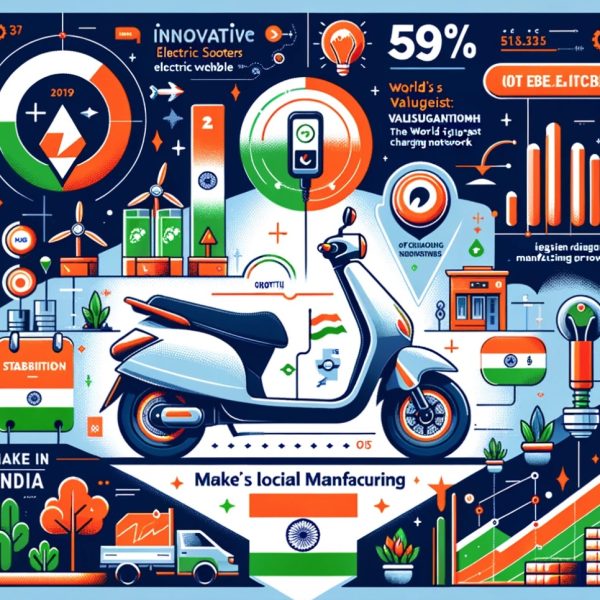Ola Electric: Accelerating India’s EV Revolution with Unmatched Innovation and Scale
February 19, 2024
Industry: Electric Vehicle

- Ola Electric is leading India’s charge into electric mobility with its innovative business model focusing on high-performance electric scooters and a vast charging infrastructure.
- Valuation has skyrocketed, reflecting strong investor confidence and the company’s aggressive expansion and innovation strategies.
- Despite stiff competition, Ola Electric’s comprehensive ecosystem offers a unique value proposition.
- Investments in infrastructure and technology are key to its strategy, with plans for the world’s largest scooter factory and an expansive charging network.
- Recent developments underscore Ola Electric’s commitment to innovation and leadership in the EV space.
Business Model
Ola Electric Mobility Pvt. Ltd., an offshoot of Ola Cabs, is pioneering in India’s EV market, focusing primarily on electric two-wheelers. The company’s business model hinges on addressing India’s massive need for sustainable and affordable transportation solutions. Ola Electric has made significant strides in developing and manufacturing electric scooters, aiming to disrupt the traditional two-wheeler market with its high-performance, zero-emission vehicles.
Central to its strategy is the establishment of the Ola Hypercharger Network, which the company touts as the world’s largest, densest electric two-wheeler charging network. This infrastructure play is pivotal, as it addresses one of the main concerns around EV adoption: range anxiety and charging convenience. Furthermore, Ola Electric is working on battery swapping technology to reduce waiting times for vehicle charging, enhancing customer convenience.
Valuation and Financial Health
As of 2024, Ola Electric has achieved a valuation of $6 billion. This valuation comes after securing $300 million in its latest funding round, underscoring significant investor confidence and marking a substantial step forward in the company’s growth trajectory.
Competitors
Ola Electric operates in a highly competitive sector, facing off against both traditional two-wheeler manufacturers and new-age EV startups. Key competitors include Ather Energy, Bajaj Auto’s electric division, TVS Motor Company’s electric ventures, and international players like Tesla looking to enter the Indian market. Despite the competition, Ola Electric differentiates itself through innovation, scale, and its comprehensive charging infrastructure.
Investors and Founders
Ola Electric is backed by a mix of strategic and financial investors, including Tiger Global, SoftBank, and the parent company, ANI Technologies Pvt. Ltd. The founding team, led by Bhavish Aggarwal, has been pivotal in steering the company through its rapid growth phases. Aggarwal’s vision for an electric mobility future for India has shaped the company’s direction and ethos.
Recent Developments
- Expansion of Manufacturing Facilities: Ola Electric has made headlines with its plans to expand the Ola Futurefactory, aiming to cement its status as the world’s largest scooter manufacturing hub. This expansion is not just about scaling production capabilities but also about advancing research and development in EV technology.
- Launch of New Models: The company has introduced new electric scooter models with enhanced features such as improved battery life, faster charging capabilities, and advanced navigation systems. These models are designed to cater to a broader segment of the market, emphasizing performance and convenience.
- Investment in Charging Infrastructure: Ola Electric has continued to invest heavily in expanding its Hypercharger Network. This initiative is crucial for not only supporting its growing customer base but also addressing one of the main barriers to EV adoption – charging infrastructure.
- International Market Entry: Recognizing the global potential for electric mobility, Ola Electric has begun operations in several international markets. This global expansion strategy is aimed at capturing market share in regions with growing demand for sustainable transportation solutions.
- Partnerships for Battery Innovation: The company has entered into strategic partnerships with global leaders in battery technology. These collaborations are focused on developing next-generation battery solutions that could significantly reduce charging times and increase the range of EVs.
Challenges
- Supply Chain Disruptions: Like many in the industry, Ola Electric has faced challenges related to supply chain disruptions, particularly for critical components like semiconductors and batteries. These disruptions have impacted production timelines and delivery schedules.
- Regulatory Hurdles: Navigating the regulatory landscape, especially in international markets, has presented challenges. Different standards for EVs and charging infrastructure can complicate expansion efforts and require significant adaptation.
- Competition: The EV market is becoming increasingly crowded, with traditional automotive giants and new entrants vying for market share. Staying ahead in terms of technology, customer experience, and price competitiveness remains a constant challenge.
- Battery Safety Concerns: There have been reports of safety incidents involving electric scooters, including those related to battery malfunctions. Addressing these concerns is paramount for maintaining consumer trust and ensuring the safety of EV technology.
- Infrastructure Development Pace: While Ola Electric is investing in charging infrastructure, the pace of development needs to match the growing EV adoption rates. Ensuring adequate charging facilities remains a critical challenge for the company and the industry at large.








